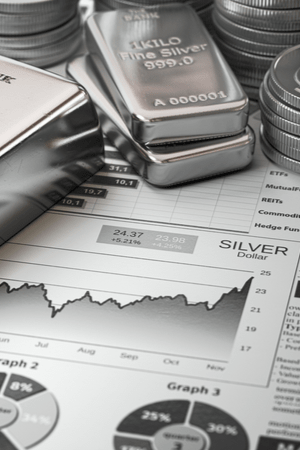Investing in silver stocks
Many listed silver producers have shares that are quite tradable. You can invest in silver this way . The share that is carried by the international price is followed by a certain price. Does the silver price rise? Then the silver share will also rise as a result.
There are of course other factors that determine how high the value of the silver stock will be, although the silver price clearly plays the leading role. This makes investing in silver easy. The available ground supply of silver and the production costs are for example two other factors that influence the silver values of the shares.
The Investment Risks of Silver
As with other investment products, there is always a chance that something goes wrong when investing. Precious metal prices can fluctuate considerably; when the economy is doing well, these prices are often under pressure. For example, when there is a crisis, the demand for gold, silver and other precious metals strangely enough increases. This can cause a price increase. Many investment products are subject to legal supervision, but this is not the case when investing in silver (and gold). Trading in silver shares can therefore be a lot of fun, but it always involves risks. Do you buy and sell your silver at the right times? Then the profit can be very high.
Why should you invest in silver stocks?
The countries of China, Russia and the United States provide the greatest demand for silver. These three countries systematically buy precious metals; do the governments of these areas have doubts about the future, when the quantitative easing is ended? If the raw materials are going to rise in the coming years, then it is best to choose silver instead of gold. Silver has a stronger history in various markets than gold, and that is also more interesting for you, as a (private) investor.

The second important reason to choose to invest in silver is the balance between supply and demand. Due to the increasing industrial demand, the demand for silver is automatically also greater. This is due to the energy sector, for example, because manufacturers of solar panels are large consumers of silver. With the increasing demand comes a decreasing supply. Various analysts predict that from 2019 onwards, the demand will be greater than the supply of silver. As a result, the silver price has increased more than the price of gold.
Investors in commodities sometimes wonder whether they should invest in silver or gold. One of the factors that ultimately decides this is the price of precious metals. Because the silver market is considerably smaller than the gold market, capital has a greater impact on the silver market than the existing influences on the gold price. In addition, you see that the demand for silver has been increasing steadily for years.
In order to predict the performance of gold versus silver, it is very important to look at the gold-silver ratio. This shows to what extent gold is valued, but then in silver terms. The chance that the silver price will outperform the gold price increases when the price of the gold-silver ratio falls below the rising blue line. This makes silver mining stocks a lot more interesting than gold mining stocks.
Physical Silver and Silver ETF as Alternatives
Choosing the right silver mining stocks is not easy. Buying physical silver also involves risks; what if it is lost or stolen? Then the choice can go to a silver ETF . By means of a silver ETF the risks are spread, and you still have the opportunity to profit from a silver sector that performs well.
Compare brokers and start investing in silver
Are you excited about investing in commodities, such as silver, after reading this article? Check out brokers that offer trading opportunities in commodities and find the broker that suits you best! Investing in commodities can be an interesting option, given that there is a physical product, the commodity, as the basis of the stock market value. A commodity, unlike a company, cannot go bankrupt, which makes this risk less significant. Of course, there are other risks when it comes to investing in silver, for example.